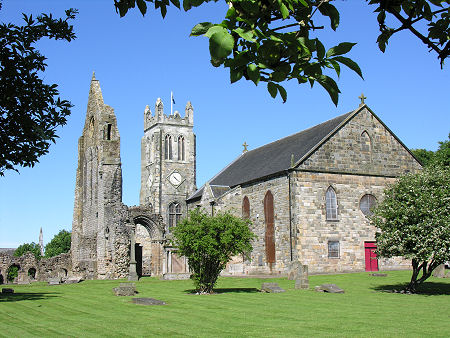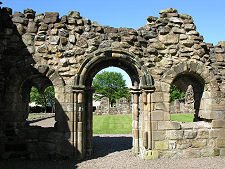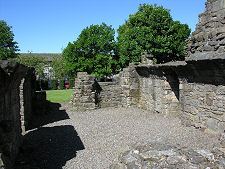 Kilwinning Abbey |
The striking ruins of Kilwinning Abbey stand in the centre of the town of Kilwinning, just over two miles inland from the North Ayrshire coast and three miles north of Irvine. Visitors should make use of the one of the nearby town centre car parks, which can be found only a short walk from the abbey. Kilwinning's Main Street effectively runs along the north side of the abbey grounds.
Though it is difficult to appreciate it today, Kilwinning Abbey was once one of the grandest abbeys in Scotland. It was founded some time between 1162 and 1187 by Tironensian monks from Kelso Abbey. The patron was probably Richard de Moreville, Lord of Cunninghame, Lord of Lauderdale and Constable of Scotland.
Richard's father, Hugh de Moreville was one of many Normans nobles granted estates in Scotland by David I as he sought to gain full control of his kingdom. It seems likely that in founding Kilwinning Abbey, Richard de Moreville was assisted by William I of Scotland.
The site chosen for the new abbey was one with long standing religious connections. Some time in the early 600s a church was founded on this site dedicated to St Winnan (also known as Finnian), a teacher of St Columba. The best evidence of this today is in the name of Kilwinning, which comes from the Gaelic for "Church of Winnian".
Building work continued at the abbey for over a century. By the end of the 1200s the building that stood here was truly magnificent. The heart of the complex was the abbey church. This was unusually broad, measuring almost 100ft across the transepts. This made it the broadest medieval church in Scotland, which eclipsed even St Andrews and Glasgow Cathedrals. Despite its width, its length, at 225ft, was relatively modest.
The abbey church's most unusual features were its towers. There were three of these in all. One stood, very conventionally, over the crossing between the nave, choir and transepts, The other two stood at the western corners of the nave. It was normal to support western towers on solid masonry walls. Those at Kilwinning were, at ground level, effectively continuations westwards of the north and south aisles, and linked to them and to the nave by 20ft high arches, one of which still stands. This allowed their ground floor space to flow into that of the nave and transepts. But it also presented an obvious structural problem, which the builders tried to overcome by supporting the tower with huge piers that were even larger than those supporting the tower of Westminster Abbey in London.
The abbey church stood on the north side of a large complex which comprised ranges of buildings around a central cloister. The abbey seems to have had a relatively calm existence for the better part of four centuries, despite evidence of repairs that suggest some damage was suffered during the wars of independence. At its peak in the 1300s and 1400s a community of around 40 monks lived, worked and prayed here, though the decline of the established church in the 1500s meant that by 1530 this number had shrunk to 16.
Over the centuries Kilwinning Abbey had 15 abbots and, later, 10 commendators or lay patrons. The most notable was Bernard of Kilwinning, who was briefly the abbot in 1296. He later served as Chancellor of Scotland in 1306, and again from 1308 to 1328. He was also Abbot of Arbroath Abbey from 1310 to 1328 and is best remembered as the probable author of the Declaration of Arbroath, one of the most important documents to emerge from medieval Scotland.
The decline seen at Kilwinning Abbey in the early 1500s appears to have been accelerated in the decades following the Reformation in 1560. The last commendator, Gavin Hamilton, was killed in a skirmish in Edinburgh in 1571 while supporting Mary Queen of Scots' failed claim to the throne. In the following decades parts of the abbey became a quarry for building projects in the area, though much of it remained standing when visited by Timothy Pont in the early 1600s.
The choir of the abbey church was adapted for use as a parish church, but this, too, was demolished in the early 1700s to provide room (and stone) for the construction of a replacement parish church now known as Abbey Church. The new church was, externally at least, a dour Presbyterian edifice whose builders clearly wanted to make it as different as they possibly could from the beautiful if fragmentary ruins that still stood around it.
One of the two western towers disappeared when the bulk of the abbey was demolished. The north-west tower stood until badly damaged by lightning in 1805. It suffered a partial collapse in 1809, and was removed in 1814 to make way for a replacement built in 1815. This has since served as a detached tower for Abbey Church and is today home to the abbey's heritage centre.
 The Abbey from the South-East |

|
|
|
Visitor InformationView Location on MapGrid Ref: NS 303 432 Kilwinning Heritage www.historicenvironment.scot HES: Abbey Web Page Open all year and admission is free. What3Words Location: ///bakers.reject.rebel |
 Chapter House |
 Slype or Vaulted Passage |
 Site of Cloister |
 Room in the West Range |
 Site of Nave |
 Arch |




